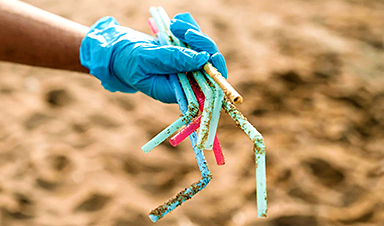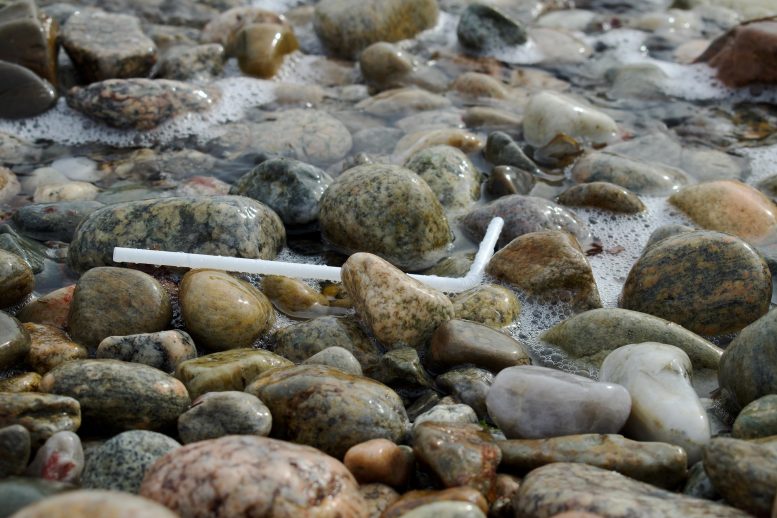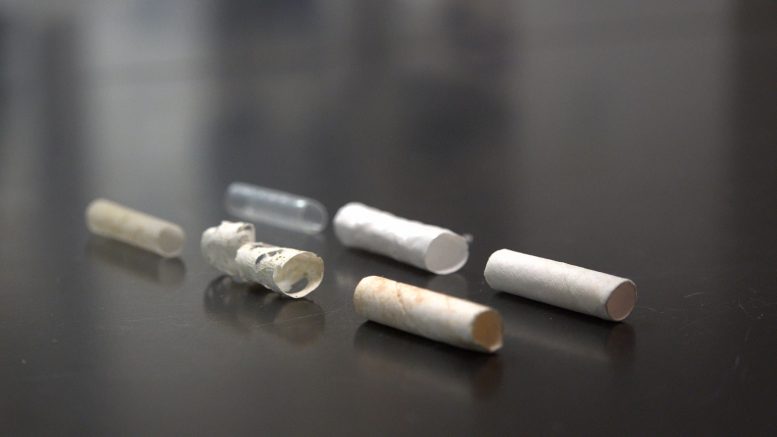Researchers determine the lifetimes of commercial drinking straws in the coastal ocean and develop a prototype bioplastic straw that degrades even faster than paper.
A WHOI study has shown that some biodegradable straws degrade up to 50% within 16 weeks in marine environments, presenting a sustainable alternative to traditional plastics and contributing to reduced ocean pollution.
Straws rank among the most prevalent plastic waste items littering coastlines. With the production, consumption, and disposal of plastic products on the rise, scientists and manufacturers are developing alternative materials that perform just as effectively without adding to ongoing environmental plastic pollution.
But not all plastics are created the same—different manufacturers have different formulations of base polymers—such as polylactic acid (PLA) and polypropylene (PP)—and chemical additives. That means different plastic formulations behave differently in the environment and break down in the ocean at different rates. There are new materials out in the market that move away from petroleum-derived products—like cellulose diacetate (CDA), a polymer derived from wood pulp that is widely used in consumer goods—and Woods Hole Oceanographic Institution (WHOI) scientists have been working to quantify the environmental lifetimes of a wide range of plastic goods to answer the unresolved question, how long do straws last in the ocean?
Straws are one of the most commonly found sources of marine litter. Researchers say we lack a firm understanding of how long plastics last in the ocean, but that science supports moving away from using the material. Credit: Bryan James/©Woods Hole Oceanographic Institution
Testing and Results on Straw Degradation
In a new paper published in ACS Sustainable Chemistry & Engineering, WHOI scientists Collin Ward, Bryan James, Chris Reddy, and Yanchen Sun put different types of plastics and paper drinking straws head-to-head to see which degrade the fastest in the coastal ocean. They partnered with scientists from bioplastic manufacturing company Eastman, who provided funding, contributed as coauthors, and supplied materials for the study.
"We lack a firm understanding of how long plastics last in the ocean, so we've been designing methods to measure how fast these materials degrade," Ward said. "It turns out, in this case, there are some bioplastic straws that actually degrade fairly quickly, which is good news."
Degradation of straws made from different types of materials were observed for 16 weeks at WHOI's Environmental Systems Lab. The tanks the straws were kept in had a continuous flow of ocean water from Martha's Vineyard Sound. Credit: Rachel Mann/©Woods Hole Oceanographic Institution
Promising Developments in Biodegradable Straws
Their approach involved suspending eight different types of straws in a tank of continuously flowing seawater from Martha's Vineyard Sound, Massachusetts. This method also controlled the temperature, light exposure, and other environmental variables to mimic the natural marine environment. All straws were monitored for signs of degradation over 16 weeks, and the microbial communities growing on the straws were characterized.
"My interest has been to understand the fate, persistence, and toxicity of plastic and how we can use that information to design next-generation materials that are better for people and the planet," James said. "We have the unique capability where we can bring the environment of the ocean on land in our tanks at the environmental systems laboratory. It gives us a very controlled environment with natural seawater."
They tested straws made of CDA, polyhydroxyalkanoates (PHA), paper, PLA, and PP. In the weeks the straws were submerged in the tanks, the CDA, PHA, and paper straws degraded by up to 50%, projecting environmental lifetimes of 10-20 months in the coastal ocean. The PLA and PP straws showed no measurable signs of degradation.
Environmental Impact of Straw Materials
The scientists then compared two straws made from CDA—one a solid and the other a foam, both provided by Eastman. The straw made from foamed CDA was a prototype to see if increasing the surface area would accelerate break down. They found that the degradation rate of the foam straw was 184% faster than its solid counterpart, resulting in a shorter projected environmental lifetime than the paper straws.
"The unique aspects of this foam straw are that it's able to have a shorter expected lifetime than the paper straws but retain the properties that you enjoy of a plastic or a bioplastic straw," James said, making it a promising alternative to conventional plastic straws compared to paper straws, which degrade quickly in the ocean but sour user experience by getting soggy, according to the authors.
Industry and Environmental Perspectives
"This study can be immensely valuable for straw manufacturers by providing informed and transparent data when selecting a material for straws. Even more, it provides reassurance that CDA-based straws won't add to the persistent plastic pollution, while also demonstrating straw manufacturers' commitment to offering a sustainable product that reduces risk to marine life," said Jeff Carbeck, Eastman's Vice President of Corporate Innovation.
The Persistent Challenge of Plastics
Science supports a push away from conventional plastic material. Plastic pollution causes harm to humans and ecosystems and the plastic industry is a large-scale contributor to climate change, accounting for roughly 4 to 5% of all greenhouse gas emissions across their lifecycle. With plastic waste becoming ubiquitous in the global ocean and marine food chain over the past 50 years, it's important to identify new materials that are sustainably sourced, contribute to the shift from a linear to a circular economy, and break down if they incidentally leak into the environment.
"While some push to shift away from plastics, the reality is that plastics are here to stay. We're trying to accept the fact that these materials are going to be used by consumers, and then we can work with companies to minimize the impacts of them should they leak into the environment," Ward said.
Collaboration for Sustainable Solutions
"We recognize the importance of testing, validating, and understanding the marine degradation of our CDA based products, but lacked the necessary resources," Carbeck said. "Knowing that WHOI possessed the expertise and facilities, we engaged in a collaborative effort to address this challenge. This partnership showcases the power of industry-academia collaboration in advancing shared goals and making a positive impact."
The research team also found that the microbial communities of the straws that degraded were unique to each straw material. However, the microbial communities on both non-degrading straws were the same despite having vastly different chemical structures. This provided further evidence that the native microbes were degrading the biodegradable straws, whereas the non-biodegradable straws likely persist in the ocean.
"Our understanding of the impacts of plastic pollution on ocean health is really uncertain, and a lot of this boils down to not knowing the long-term fates of these materials," Ward said. He and the rest of the research team plan to continue measuring the degradability of plastic materials, with the hope of guiding where the industry goes next.
"There are a lot of advantages of partnering with material manufacturers, including access to analytical facilities, and knowledge about and access to their materials that you don't get if you work in your own silo," Ward said. "We're trying to optimize their products for degradation in the environment and ultimately the good of the planet."
Key Takeaways
- Not all plastics are created the same, and some last longer in the ocean than others. WHOI scientists have been working for years to quantify the environmental lifetimes of a wide range of plastic goods to see which have the shortest and longest lifespans in the ocean. To determine what plastics persist in the ocean, the team tests different products in large tanks that recreate the natural ocean environment. They focused on drinking straws first, as they are one of the most prevalent forms of plastic waste found in beach cleanups.
- The authors found that straws made from cellulose diacetate (CDA), polyhydroxyalkanoates (PHA), and paper degraded by up to 50% in 16 weeks. They all had unique microbial communities that helped break down the material.
- A prototype straw from Eastman, made of foamed CDA, degraded more quickly than the solid, meaning that altering the surface area of the straw can speed up the degradation process.
- Science supports a shift away from persistent plastics—making it even more important to ensure new materials break down if they leak into the environment and don't further pollute the ocean.
Reference: "Strategies to Reduce the Environmental Lifetimes of Drinking Straws in the Coastal Ocean" by Bryan D. James, Yanchen Sun, Mounir Izallalen, Sharmistha Mazumder, Steven T. Perri, Brian Edwards, Jos de Wit, Christopher M. Reddy and Collin P. Ward, 30 January 2024, ACS Sustainable Chemistry & Engineering.
DOI: 10.1021/acssuschemeng.3c07391
News
Platelet-inspired nanoparticles could improve treatment of inflammatory diseases
Scientists have developed platelet-inspired nanoparticles that deliver anti-inflammatory drugs directly to brain-computer interface implants, doubling their effectiveness. Scientists have found a way to improve the performance of brain-computer interface (BCI) electrodes by delivering anti-inflammatory drugs directly [...]
After 150 years, a new chapter in cancer therapy is finally beginning
For decades, researchers have been looking for ways to destroy cancer cells in a targeted manner without further weakening the body. But for many patients whose immune system is severely impaired by chemotherapy or radiation, [...]
Older chemical libraries show promise for fighting resistant strains of COVID-19 virus
SARS‑CoV‑2, the virus that causes COVID-19, continues to mutate, with some newer strains becoming less responsive to current antiviral treatments like Paxlovid. Now, University of California San Diego scientists and an international team of [...]
Lower doses of immunotherapy for skin cancer give better results, study suggests
According to a new study, lower doses of approved immunotherapy for malignant melanoma can give better results against tumors, while reducing side effects. This is reported by researchers at Karolinska Institutet in the Journal of the National [...]
Researchers highlight five pathways through which microplastics can harm the brain
Microplastics could be fueling neurodegenerative diseases like Alzheimer's and Parkinson's, with a new study highlighting five ways microplastics can trigger inflammation and damage in the brain. More than 57 million people live with dementia, [...]
Tiny Metal Nanodots Obliterate Cancer Cells While Largely Sparing Healthy Tissue
Scientists have developed tiny metal-oxide particles that push cancer cells past their stress limits while sparing healthy tissue. An international team led by RMIT University has developed tiny particles called nanodots, crafted from a metallic compound, [...]
Gold Nanoclusters Could Supercharge Quantum Computers
Researchers found that gold “super atoms” can behave like the atoms in top-tier quantum systems—only far easier to scale. These tiny clusters can be customized at the molecular level, offering a powerful, tunable foundation [...]
A single shot of HPV vaccine may be enough to fight cervical cancer, study finds
WASHINGTON -- A single HPV vaccination appears just as effective as two doses at preventing the viral infection that causes cervical cancer, researchers reported Wednesday. HPV, or human papillomavirus, is very common and spread [...]
New technique overcomes technological barrier in 3D brain imaging
Scientists at the Swiss Light Source SLS have succeeded in mapping a piece of brain tissue in 3D at unprecedented resolution using X-rays, non-destructively. The breakthrough overcomes a long-standing technological barrier that had limited [...]
Scientists Uncover Hidden Blood Pattern in Long COVID
Researchers found persistent microclot and NET structures in Long COVID blood that may explain long-lasting symptoms. Researchers examining Long COVID have identified a structural connection between circulating microclots and neutrophil extracellular traps (NETs). The [...]
This Cellular Trick Helps Cancer Spread, but Could Also Stop It
Groups of normal cbiells can sense far into their surroundings, helping explain cancer cell migration. Understanding this ability could lead to new ways to limit tumor spread. The tale of the princess and the [...]
New mRNA therapy targets drug-resistant pneumonia
Bacteria that multiply on surfaces are a major headache in health care when they gain a foothold on, for example, implants or in catheters. Researchers at Chalmers University of Technology in Sweden have found [...]
Current Heart Health Guidelines Are Failing To Catch a Deadly Genetic Killer
New research reveals that standard screening misses most people with a common inherited cholesterol disorder. A Mayo Clinic study reports that current genetic screening guidelines overlook most people who have familial hypercholesterolemia, an inherited disorder that [...]
Scientists Identify the Evolutionary “Purpose” of Consciousness
Summary: Researchers at Ruhr University Bochum explore why consciousness evolved and why different species developed it in distinct ways. By comparing humans with birds, they show that complex awareness may arise through different neural architectures yet [...]
Novel mRNA therapy curbs antibiotic-resistant infections in preclinical lung models
Researchers at the Icahn School of Medicine at Mount Sinai and collaborators have reported early success with a novel mRNA-based therapy designed to combat antibiotic-resistant bacteria. The findings, published in Nature Biotechnology, show that in [...]
New skin-permeable polymer delivers insulin without needles
A breakthrough zwitterionic polymer slips through the skin’s toughest barriers, carrying insulin deep into tissue and normalizing blood sugar, offering patients a painless alternative to daily injections. A recent study published in the journal Nature examines [...]























